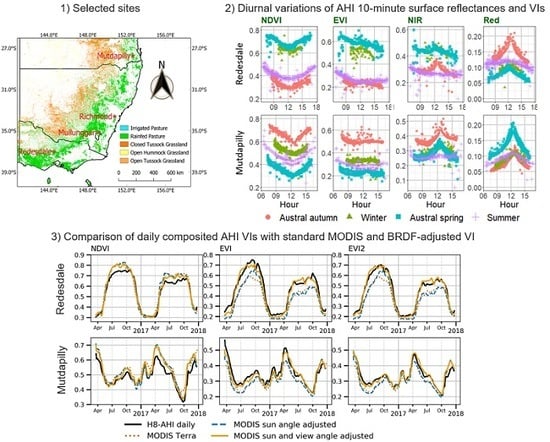Seasonal Comparisons of Himawari-8 AHI and MODIS Vegetation Indices over Latitudinal Australian Grassland Sites
Abstract
1. Introduction
2. Materials and Methods
2.1. Study Sites
2.2. Himawari-8 AHI Data
2.3. Comparisons of MODIS VI Products with Himawari-8 AHI
2.4. Compositing Himawari-8 AHI VIs to Daily Values
3. Results
3.1. Diurnal Himawari-8 AHI VI Variations in Relation to Solar Zenith Angle Variations
3.2. Seasonal Variations in Daily Composited Himawari-8 AHI VI Time Series
3.3. Seasonal Comparisons of Himawari-8 AHI and MODIS VIs
3.4. AHI and MODIS VI Relationships before and after Sun-View Geometry Adjustment
4. Discussion
5. Conclusions
Author Contributions
Funding
Acknowledgments
Conflicts of Interest
References
- Bessho, K.; Date, K.; Hayashi, M.; Ikeda, A.; Imai, T.; Inoue, H.; Kumagai, Y.; Miyakawa, T.; Murata, H.; Ohno, T.; et al. An introduction to Himawari-8/9 — Japan’s new-generation geostationary meteorological satellites. J. Meteorol. Soc. Jpn. 2016, 94, 151–183. [Google Scholar] [CrossRef]
- Choi, Y.S.; Ho, C.H. Earth and environmental remote sensing community in South Korea: A review. Remote Sens. Appl. Soc. Environ. 2015, 2, 66–76. [Google Scholar] [CrossRef]
- Goodman, S.J. GOES-R Series Introduction. The GOES-R Series: A New Generation of Geostationary Environmental Satellites; Elsevier: Amsterdam, The Netherlands, 2019; pp. 1–3. [Google Scholar]
- Zhang, P.; Zhu, L.; Tang, S.; Gao, L.; Chen, L.; Zheng, W.; Han, X.; Chen, J.; Shao, J. General comparison of FY-4A/AGRI with other GEO/LEO instruments and its potential and challenges in non-meteorological applications. Front. Earth Sci. 2019, 6, 1–13. [Google Scholar] [CrossRef]
- Miura, T.; Nagai, S.; Takeuchi, M.; Ichii, K.; Yoshioka, H. Improved Characterisation of Vegetation and Land Surface Seasonal Dynamics in Central Japan with Himawari-8 Hypertemporal Data. Sci. Rep. 2019, 9, 1–12. [Google Scholar]
- Li, S.; Wang, W.; Hashimoto, H.; Xiong, J.; Vandal, T.; Yao, J.; Qian, L.; Ichii, K.; Lyapustin, A.; Wang, Y.; et al. First provisional land surface reflectance product from geostationary satellite Himawari-8 AHI. Remote Sens. 2019, 11, 1–12. [Google Scholar] [CrossRef]
- Fensholt, R.; Ayamba, A.; Stisen, S.; Sandholt, I.; Pak, E.; Small, J. Comparisons of compositing period length for vegetation index data from polar-orbiting and geostationary satellites for the cloud-prone region of West Africa. Photogramm. Eng. Remote Sens. 2007, 73, 297–309. [Google Scholar] [CrossRef]
- Guan, K.; Medvigy, D.; Wood, E.F.; Caylor, K.K.; Li, S.; Jeong, S.J. Deriving vegetation phenological time and trajectory information over africa using seviri daily LAI. Ieee Trans. Geosci. Remote Sens. 2014, 52, 1113–1130. [Google Scholar] [CrossRef]
- Yan, D.; Zhang, X.; Yu, Y.; Guo, W. A Comparison of Tropical Rainforest Phenology Retrieved from Geostationary (SEVIRI) and Polar-Orbiting (MODIS) Sensors Across the Congo Basin. Ieee Trans. Geosci. Remote Sens. 2016, 54, 4867–4881. [Google Scholar] [CrossRef]
- Chen, Y.; Sun, K.; Chen, C.; Bai, T.; Park, T.; Wang, W.; Nemani, R.R.; Myneni, R.B. Generation and evaluation of LAI and FPAR products from Himawari-8 advanced Himawari imager (AHI) data. Remote Sens. 2019, 11. [Google Scholar] [CrossRef]
- He, T.; Zhang, Y.; Liang, S.; Yu, Y. Developing Land Surface Directional Reflectance and Albedo Products from Geostationary GOES-R and Himawari Data: Theoretical Basis, Operational Implementation, and Validation. Remote Sens. 2019, 1–21. [Google Scholar] [CrossRef]
- Adachi, Y.; Kikuchi, R.; Obata, K.; Yoshioka, H. Relative azimuthal-angle matching (RAM): A screening method for GEO-LEO reflectance comparison in middle latitude forests. Remote Sens. 2019, 11. [Google Scholar] [CrossRef]
- Wheeler, K.I.; Dietze, M.C. A statistical model for estimating Midday NDVI from the Geostationary Operational Environmental Satellite (GOES) 16 and 17. Remote Sens. 2019, 11. [Google Scholar] [CrossRef]
- Fensholt, R.; Sandholt, I.; Stisen, S.; Tucker, C. Analysing NDVI for the African continent using the geostationary meteosat second generation SEVIRI sensor. Remote Sens. Environ. 2006, 101, 212–229. [Google Scholar] [CrossRef]
- Sobrino, J.A.; Julien, Y.; Soria, G. Phenology estimation from meteosat second generation data. IEEE J. Sel. Top. Appl. Earth Obs. Remote Sens. 2013, 6, 1653–1659. [Google Scholar] [CrossRef]
- Fang, L.; Zhan, X.; Schull, M.; Kalluri, S.; Laszlo, I.; Yu, P.; Carter, C.; Hain, C.; Anderson, M. Evapotranspiration data product from NESDIS GET-D system upgraded for GOES-16 ABI observations. Remote Sens. 2019, 11. [Google Scholar] [CrossRef]
- Yan, D.; Zhang, X.; Nagai, S.; Yu, Y.; Akitsu, T.; Nasahara, K.N.; Ide, R.; Maeda, T. Evaluating land surface phenology from the Advanced Himawari Imager using observations from MODIS and the Phenological Eyes Network. Int. J. Appl. Earth Obs. Geoinf. 2019, 79, 71–83. [Google Scholar] [CrossRef]
- Sobrino, J.A.; Julien, Y. Trend Analysis of Global MODIS-Terra Vegetation Indices and Land Surface Temperature Between 2000 and 2011. Ieee J. Sel. Top. Appl. Earth Obs. Remote Sens. 2013, 6, 2139–2145. [Google Scholar] [CrossRef]
- Yan, D.; Zhang, X.; Yu, Y.; Guo, W.; Hanan, N.P. Characterizing land surface phenology and responses to rainfall in the Sahara desert. J. Geophys. Res. Biogeosciences 2016, 121, 2243–2260. [Google Scholar] [CrossRef]
- Qin, Y.; McVicar, T.R. Spectral band unification and inter-calibration of Himawari AHI with MODIS and VIIRS: Constructing virtual dual-view remote sensors from geostationary and low-Earth-orbiting sensors. Remote Sens. Environ. 2018, 209, 540–550. [Google Scholar] [CrossRef]
- Purbantoro, B.; Aminuddin, J.; Manago, N.; Toyoshima, K.; Lagrosas, N.; Sumantyo, J.T.S.; Kuze, H. Comparison of aqua/terra MODIS and Himawari-8 satellite data on cloud mask and cloud type classification using split window algorithm. Remote Sens. 2019, 11, 1–19. [Google Scholar] [CrossRef]
- Roujean, J.-L.; Leroy, M.; Deschamps, P.-Y. A bidirectional reflectance model of the Earth’s surface for the correction of remote sensing data. J. Geophys. Res. 1992, 97, 20455. [Google Scholar] [CrossRef]
- Middleton, E.M. Solar zenith angle effects on vegetation indices in tallgrass prairie. Remote Sens. Environ. 1991, 38, 45–62. [Google Scholar] [CrossRef]
- Ma, X.; Huete, A.; Tran, N.N. Interaction of seasonal sun-angle and savanna phenology observed and modelled using MODIS. Remote Sens. 2019, 11, 1–19. [Google Scholar] [CrossRef]
- Morton, D.C.; Nagol, J.; Carabajal, C.C.; Rosette, J.; Palace, M.; Cook, B.D.; Vermote, E.F.; Harding, D.J.; North, P.R.J. Amazon forests maintain consistent canopy structure and greenness during the dry season. Nature 2014, 506, 221–224. [Google Scholar] [CrossRef]
- Sims, D.A.; Rahman, A.F.; Vermote, E.F.; Jiang, Z. Seasonal and inter-annual variation in view angle effects on MODIS vegetation indices at three forest sites. Remote Sens. Environ. 2011, 115, 3112–3120. [Google Scholar] [CrossRef]
- Bhandari, S.; Phinn, S.; Gill, T. Assessing viewing and illumination geometry effects on the MODIS vegetation index (MOD13Q1) time series: implications for monitoring phenology and disturbances in forest communities in Queensland, Australia. Int. J. Remote Sens. 2011, 32, 7513–7538. [Google Scholar] [CrossRef]
- Medek, D.E.; Beggs, P.J.; Erbas, B.; Jaggard, A.K.; Campbell, B.C.; Vicendese, D.; Johnston, F.H.; Godwin, I.; Huete, A.R.; Green, B.J.; et al. Regional and seasonal variation in airborne grass pollen levels between cities of Australia and New Zealand. Aerobiol. (Bologna). 2016, 32, 289–302. [Google Scholar] [CrossRef]
- Matsuoka, M.; Honda, R.; Nonomura, A.; Moriya, H.; Akatsuka, S.; Yoshioka, H.; Takagi, M. A method to improve geometric accuracy of Himawari-8/AHI “Japan Area” data. J. Jpn. Soc. Photogramm. Remote Sens 2016, 54, 280–289. [Google Scholar]
- Lyapustin, A.I.; Wang, Y.; Laszlo, I.; Hilker, T.; Hall, G.F.; Sellers, P.J.; Tucker, C.J.; Korkin, S.V. V. Multi-angle implementation of atmospheric correction for MODIS (MAIAC): 3. Atmospheric correction. Remote Sens. Environ. 2012, 127, 385–393. [Google Scholar] [CrossRef]
- Ishihara, M.; Inoue, Y.; Ono, K.; Shimizu, M.; Matsuura, S. The impact of sunlight conditions on the consistency of vegetation indices in croplands-Effective usage of vegetation indices from continuous ground-based spectral measurements. Remote Sens. 2015, 7, 14079–14098. [Google Scholar] [CrossRef]
- Ma, X.; Huete, A.; Tran, N.N.; Bi, J.; Gao, S.; Zeng, Y. Sun-Angle Effects on Remote-Sensing Phenology Observed and Modelled Using Himawari-8. Remote Sens. 2020, 12, 1339. [Google Scholar] [CrossRef]
- Jiang, Z.; Huete, A.R.; Didan, K.; Miura, T. Development of a two-band enhanced vegetation index without a blue band. Remote Sens. Environ. 2008, 112, 3833–3845. [Google Scholar] [CrossRef]
- Rouse, J.W.; Hass, R.H.; Schell, J.A.; Deering, D.W. Monitoring vegetation systems in the great plains with ERTS. Third Earth Resour. Technol. Satell. Symp. 1973, 1, 309–317. [Google Scholar]
- Huete, A.; Didan, K.; Miura, T.; Rodriguez, E.P.; Gao, P.; Ferreira, L.G. Overview of the radiometric and biophysical performance of the MODIS vegetation indices. Remote Sens. Environ. 2002, 83, 195–213. [Google Scholar] [CrossRef]
- Jarchow, C.J.; Didan, K.; Barreto-Muñoz, A.; Nagler, P.L.; Glenn, E.P. Application and comparison of the MODIS-derived enhanced vegetation index to VIIRS, landsat 5 TM and landsat 8 OLI platforms: A case study in the arid colorado river delta, Mexico. Sensors 2018, 18. [Google Scholar] [CrossRef]
- Myneni, R.B.; Hall, F.G.; Sellers, P.J.; Marshak, A.L. The interpretation of spectral vegetation indices. IEEE Trans. Geosci. Remote Sens. 1995, 33, 481–486. [Google Scholar] [CrossRef]
- Zhang, X.; Friedl, M.A.; Schaaf, C.B.; Strahler, A.H.; Hodges, J.C.F.; Gao, F.; Reed, B.C.; Huete, A. Monitoring vegetation phenology using MODIS. Remote Sens. Environ. 2003, 84, 471–475. [Google Scholar] [CrossRef]
- De Beurs, K.M.; Henebry, G.M. Spatio-Temporal Statistical Methods for Modelling Land Surface Phenology. In Phenological Research: Methods for Environmental and Climate Change Analysis; Hudson, I.L., Keatley, M.R., Eds.; Springer: Dordrecht, UK, 2010; pp. 177–208. ISBN 978-90-481-3334-5. [Google Scholar]
- Jeganathan, C.; Dash, J.; Atkinson, P.M. Remotely sensed trends in the phenology of northern high latitude terrestrial vegetation, controlling for land cover change and vegetation type. Remote Sens. Environ. 2014, 143, 154–170. [Google Scholar] [CrossRef]
- Broich, M.; Huete, A.; Paget, M.; Ma, X.; Tulbure, M.; Coupe, N.R.; Evans, B.; Beringer, J.; Devadas, R.; Davies, K.; et al. A spatially explicit land surface phenology data product for science, monitoring and natural resources management applications. Environ. Model. Softw. 2015, 64, 191–204. [Google Scholar] [CrossRef]
- Didan, K. MOD13Q1 MODIS/Terra Vegetation Indices 16-Day L3 Global 250m SIN Grid V006 [Data set] 2015. MOD13Q1 v006. Available online: https://doi.org/10.5067/MODIS/MOD13Q1.006 (accessed on 2 August 2020).
- Vermote, E.; Justice, C.O.; Breon, F.M. Towards a Generalized Approach for Correction of the BRDF Effect in MODIS Directional Reflectances. IEEE Trans. Geosci. Remote Sens. 2009, 47, 898–908. [Google Scholar] [CrossRef]
- Strahler, A.H.; Muller, J.P. MODIS BRDF Albedo Product: Algorithm Theoretical Basis Document. Vesion 5. 1999; pp. 1–53. Available online: https://modis.gsfc.nasa.gov/data/atbd/atbd_mod09.pdf (accessed on 22 June 2020).
- Schaaf, C.B.; Gao, F.; Strahler, A.H.; Lucht, W.; Li, X.; Tsang, T.; Strugnell, N.C.; Zhang, X.; Jin, Y.; Muller, J.P.; et al. First operational BRDF, albedo nadir reflectance products from MODIS. Remote Sens. Environ. 2002, 83, 135–148. [Google Scholar] [CrossRef]
- Schaaf, C.; Wang, Z. MCD43A1 MODIS/Terra+Aqua BRDF/Albedo Model Parameters Daily L3 Global - 500m V006 2015. MCD43A1 v006. Available online: https://doi.org/10.5067/MODIS/MCD43A1.006 (accessed on 2 August 2020).
- Strahler, A.; Gopal, S.; Lambin, E.; Moody, A. MODIS Land Cover Product Algorithm Theoretical Basis Document ( ATBD ) MODIS Land Cover and Land-Cover Change. Change 1999, 72. [Google Scholar]
- Savitzky, A.; Golay, M.J.E. Smoothing and Differentiation of Data by Simplified Least Squares Procedures. Anal. Chem. 1964, 36, 1627–1639. [Google Scholar] [CrossRef]
- Didan, K.; Munoz, A.B.; Huete, A. MODIS Vegetation Index User ’ s Guide ( MOD13 Series ). 2015. Available online: https://vip.arizona.edu/documents/MODIS/MODIS_VI_UsersGuide_June_2015_C6.pdf (accessed on 22 June 2020).
- Vargas, M.; Miura, T.; Shabanov, N.; Kato, A. An initial assessment of Suomi NPP VIIRS vegetation index EDR. J. Geophys. Res. Atmos. 2013, 118, 12,301–12,316. [Google Scholar] [CrossRef]
- Pinzon, J.E.; Tucker, C.J. A non-stationary 1981-2012 AVHRR NDVI3g time series. Remote Sens. 2014, 6, 6929–6960. [Google Scholar] [CrossRef]
- Gao, F.; Jin, Y.; Li, X.; Schaaf, C.B.; Strahler, A.H. Bidirectional NDVI and atmospherically resistant BRDF inversion for vegetation canopy. Ieee Trans. Geosci. Remote Sens. 2002, 40, 1269–1278. [Google Scholar]
- Leblanc, S.C.; Chen, J.M.; Cihlar, J. Ndvi directionality in boreal forests: A model interpretation of measurements. Can. J. Remote Sens. 1997, 23, 369–380. [Google Scholar] [CrossRef]
- Zhang, X.; Qiu, F.; Zhan, C.; Zhang, Q.; Li, Z.; Wu, Y.; Huang, Y.; Chen, X. Acquisitions and applications of forest canopy hyperspectral imageries at hotspot and multiview angle using unmanned aerial vehicle platform. J. Appl. Remote Sens. 2020, 14, 1–16. [Google Scholar] [CrossRef]
- Fensholt, R.; Sandholt, I.; Proud, S.R.; Stisen, S.; Rasmussen, M.O. Assessment of MODIS sun-sensor geometry variations effect on observed NDVI using MSG SEVIRI geostationary data. Int. J. Remote Sens. 2010, 31, 6163–6187. [Google Scholar] [CrossRef]
- Li, X.; Strahler, A.H. Geometric-optical bidirectional reflectance modeling of the discrete crown vegetation canopy: effect of crown shape and mutual shadowing. Ieee Trans. Geosci. Remote Sens. 1992, 30, 276–292. [Google Scholar] [CrossRef]
- Bréon, F.M.; Vermote, E. Correction of MODIS surface reflectance time series for BRDF effects. Remote Sens. Environ. 2012, 125, 1–9. [Google Scholar] [CrossRef]
- Middleton, E.M. Quantifying reflectance anisotropy of photosynthetically active radiation in grasslands. J. Geophys. Res. Atmos. 1992, 97, 18935–18946. [Google Scholar] [CrossRef]


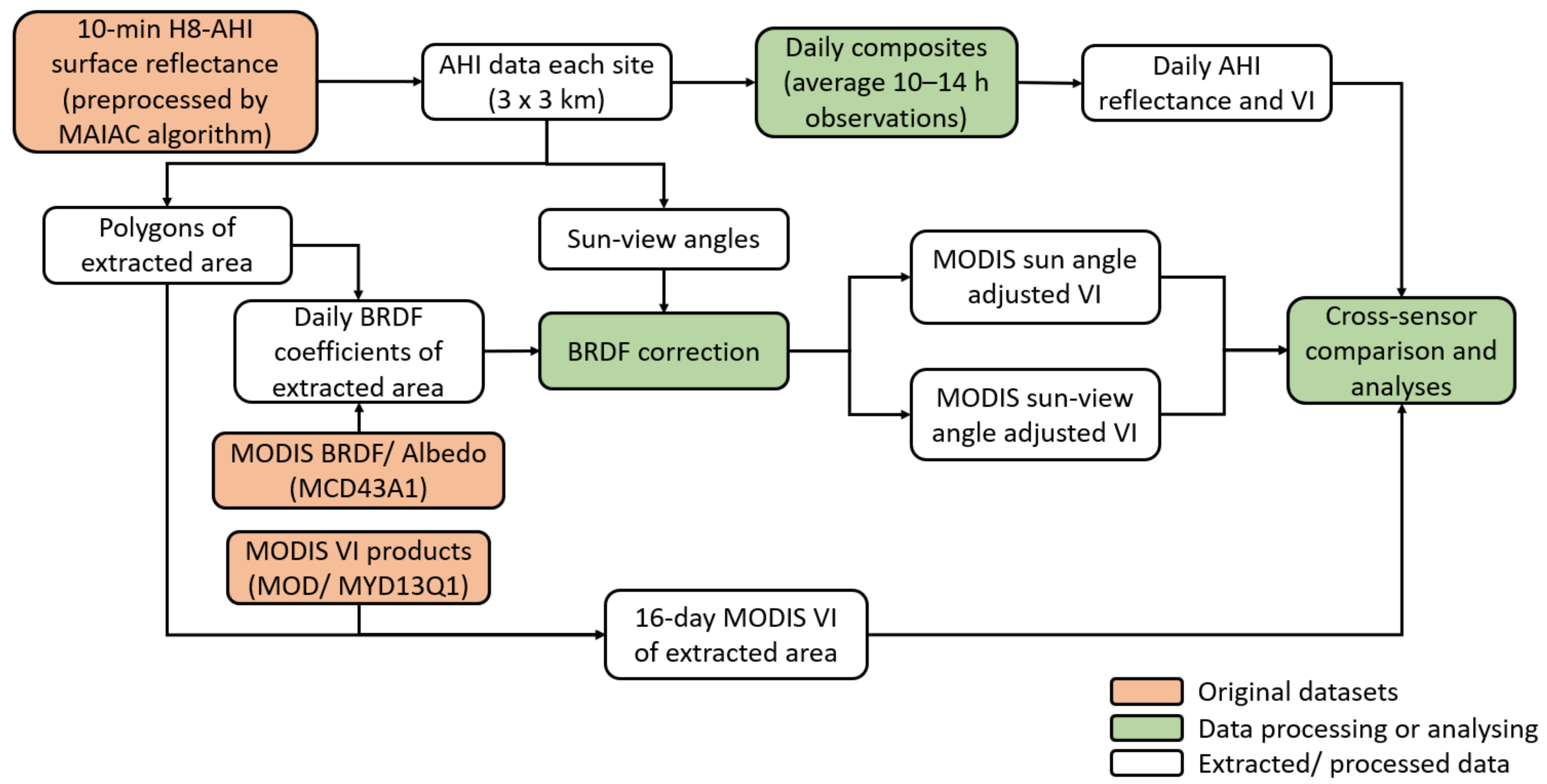

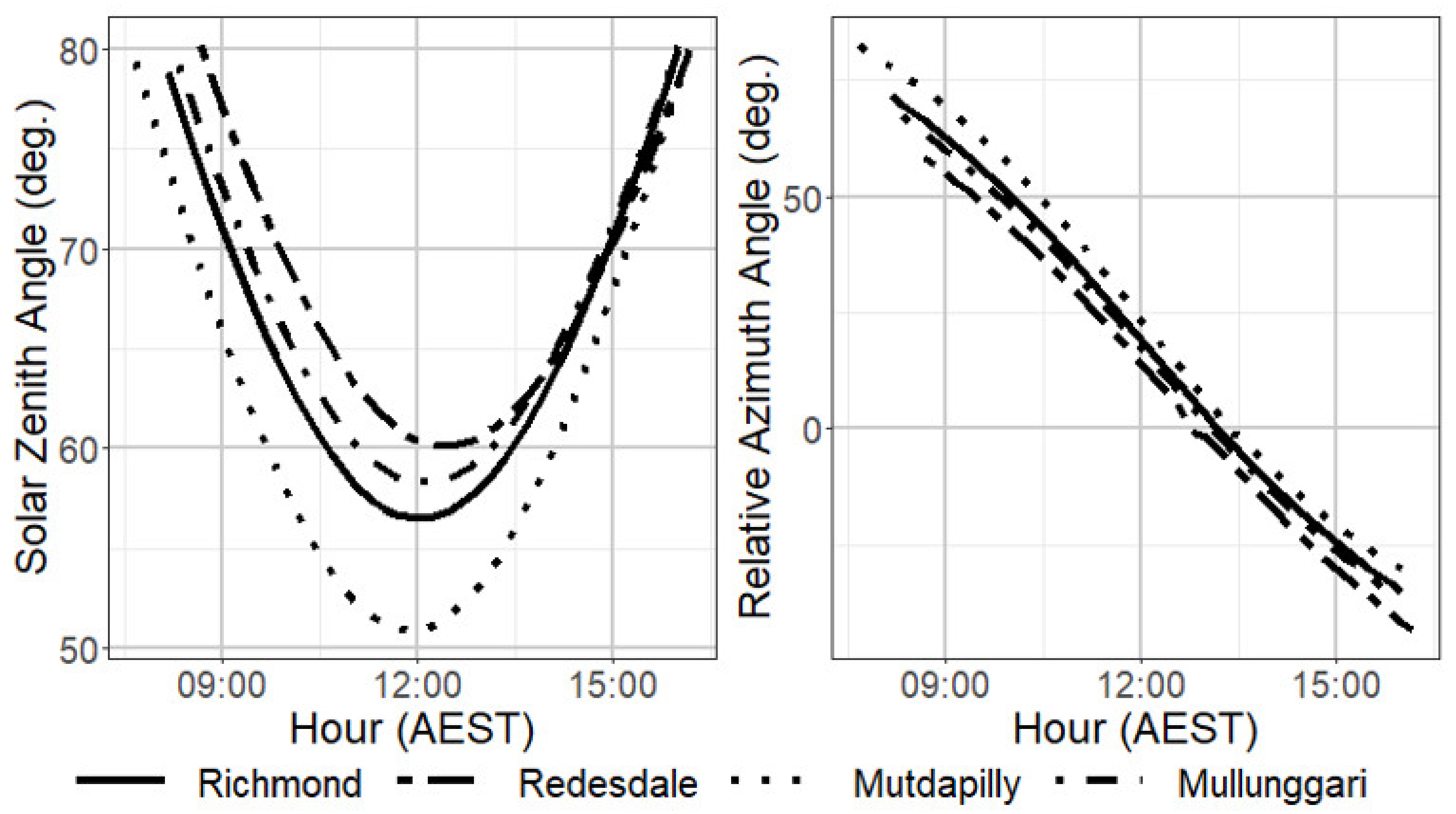
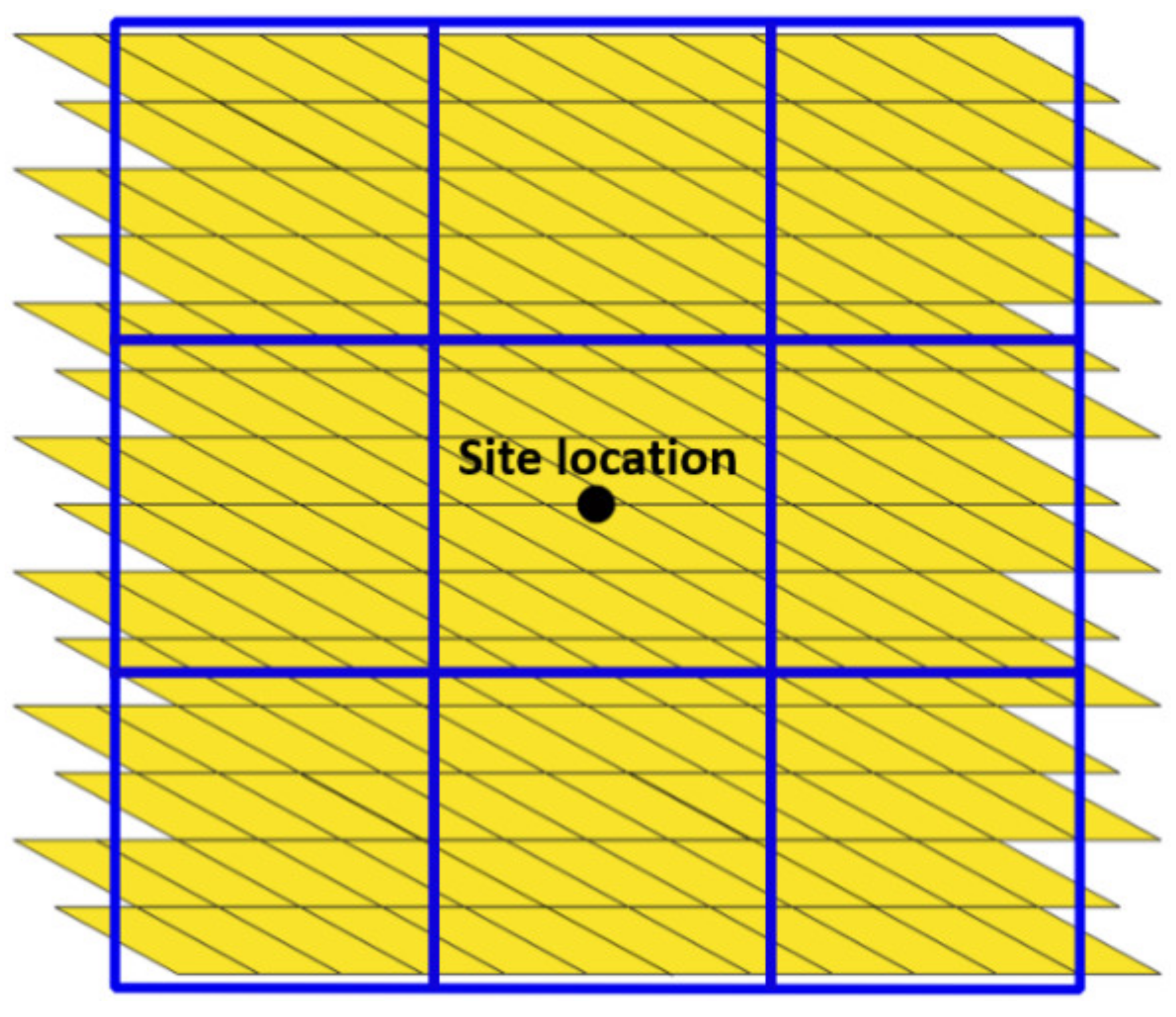
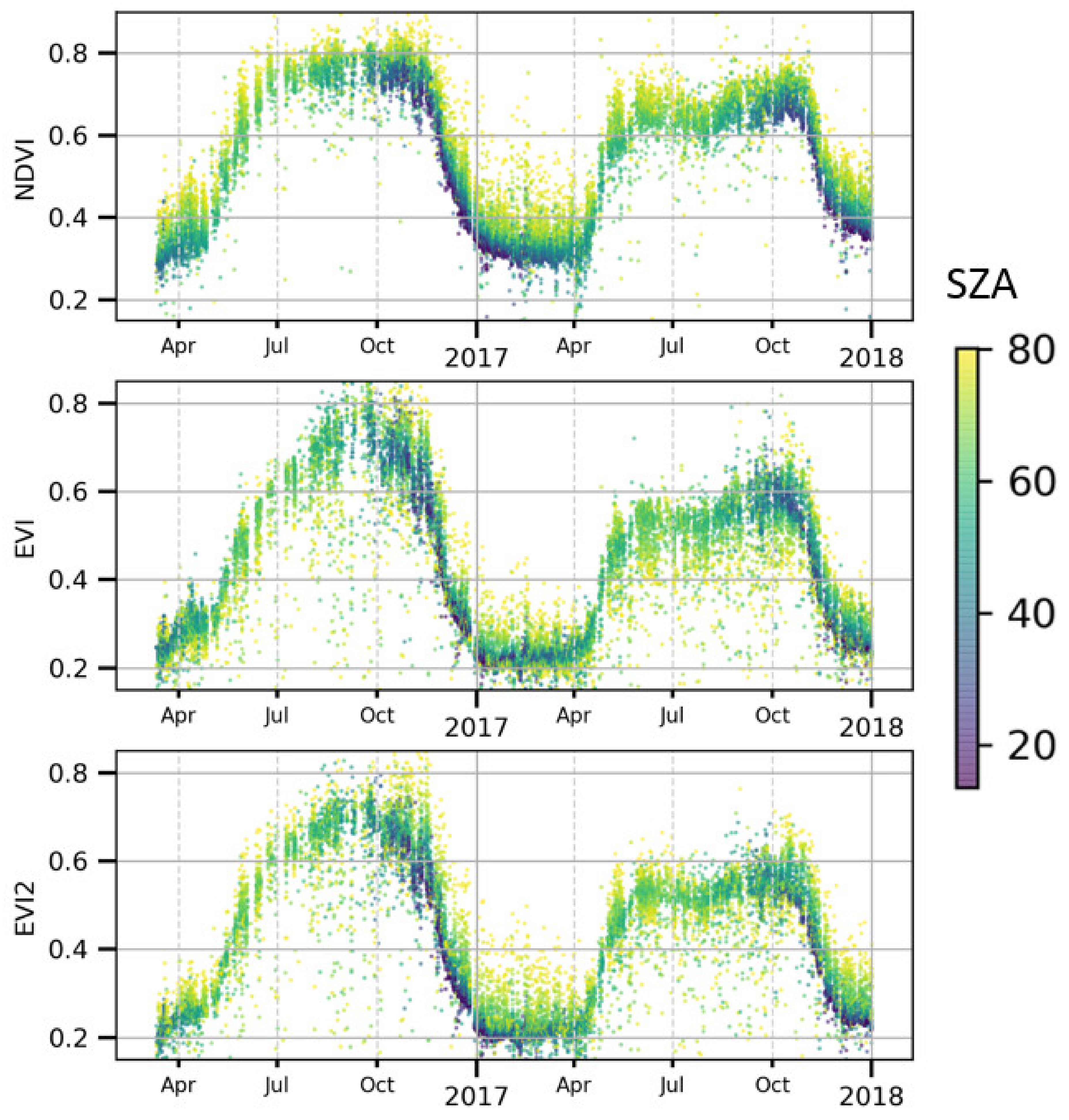
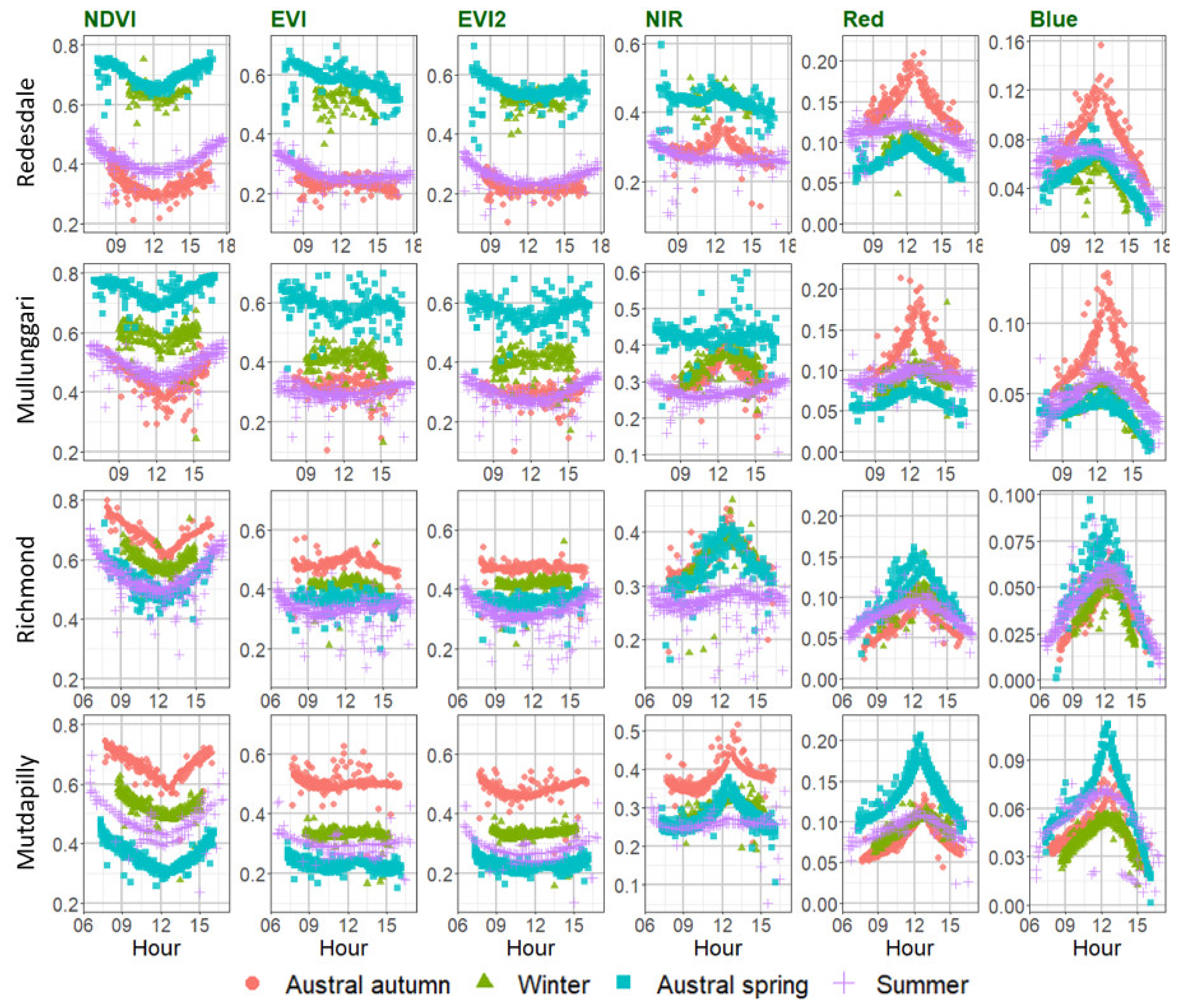

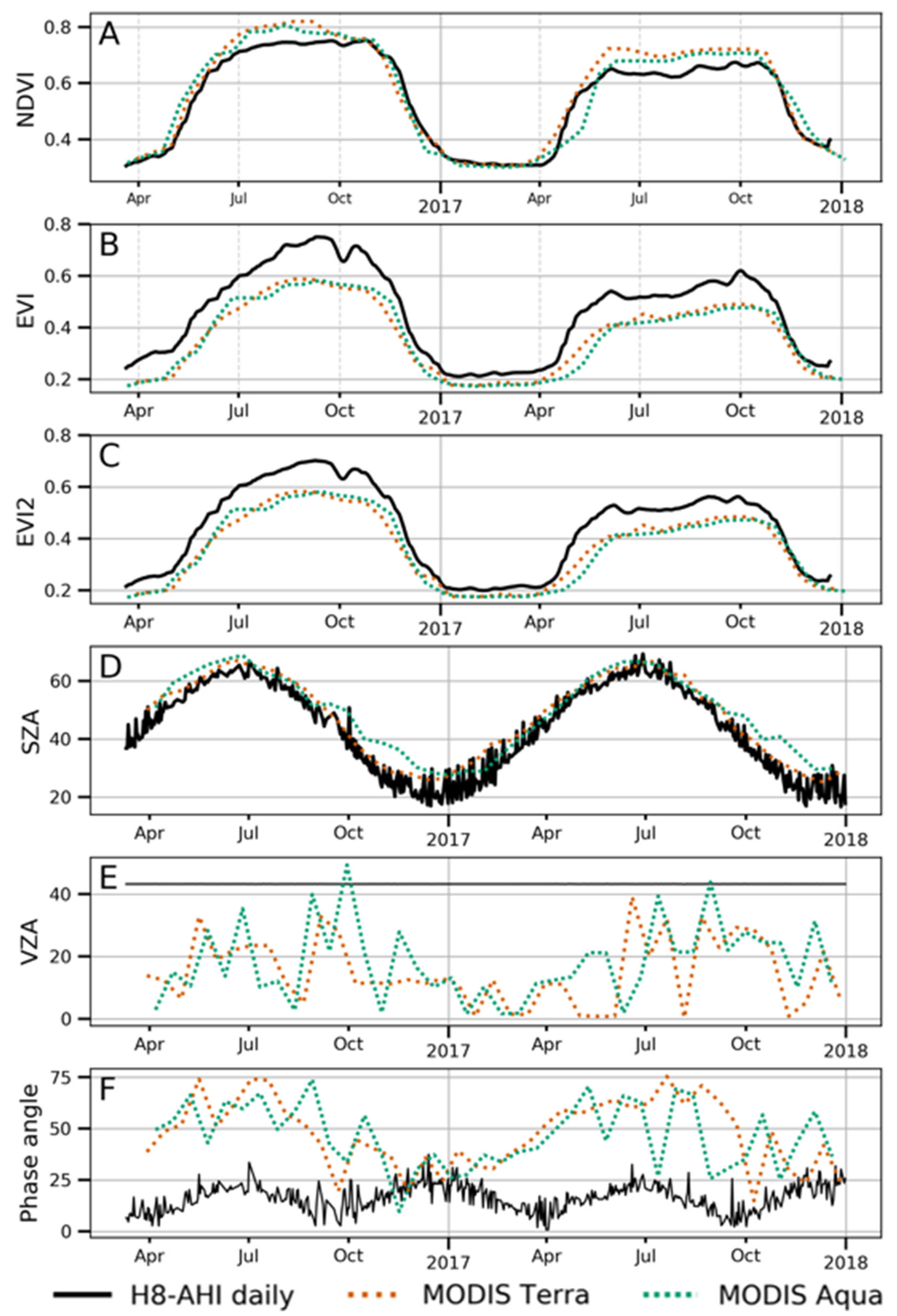

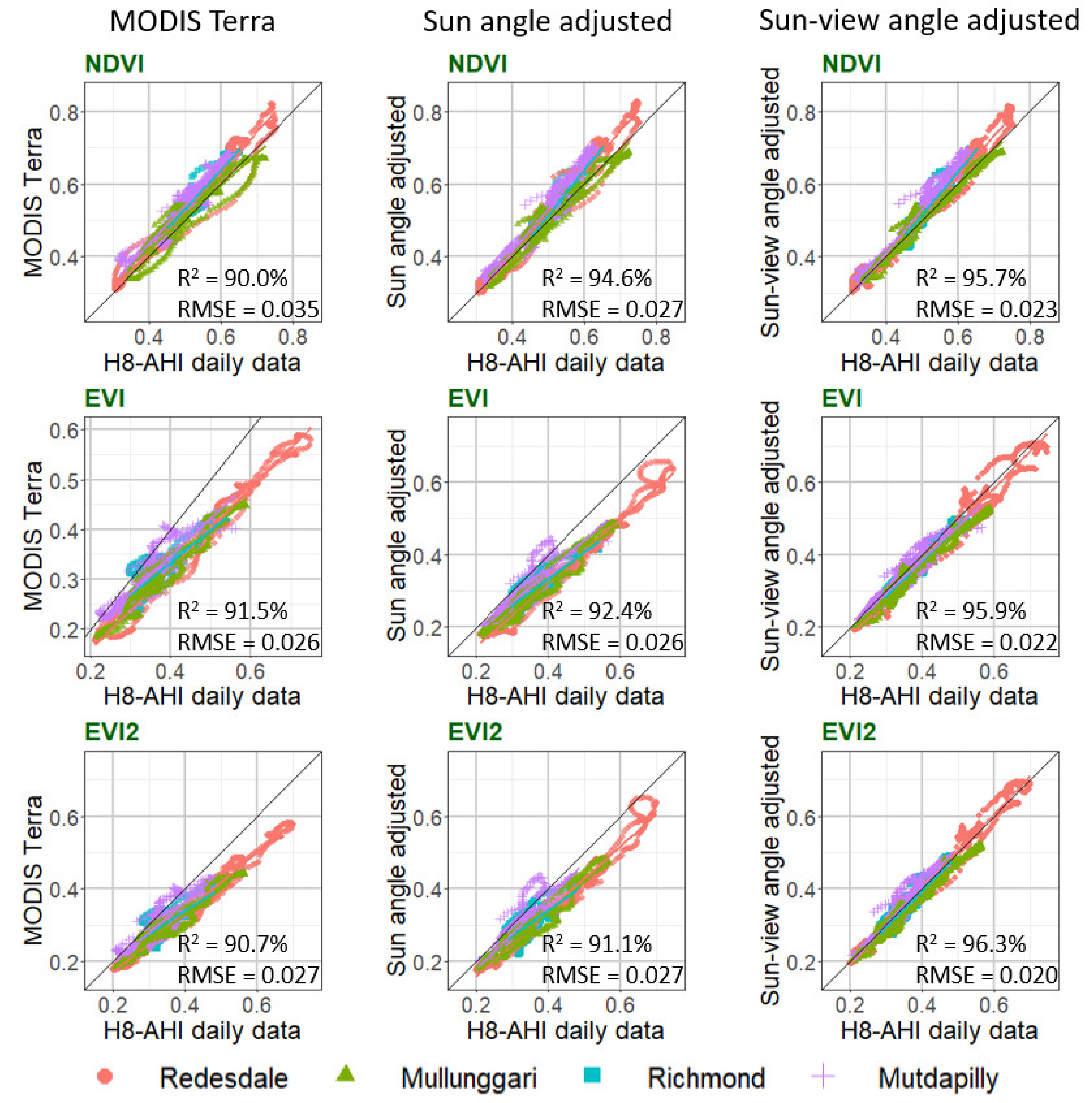
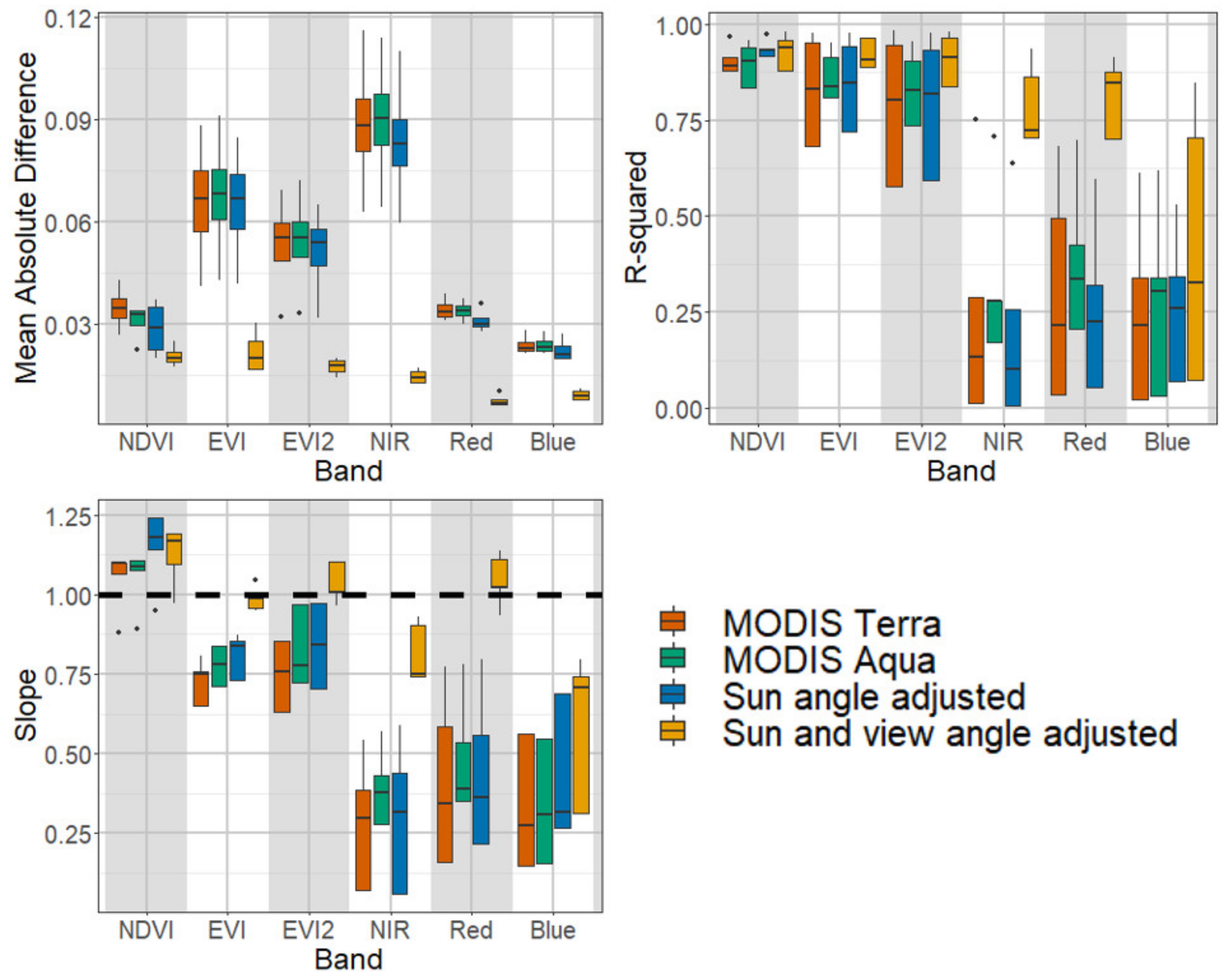
| Site Name | State/Territory | Long | Lat | AHI View Zenith Angle | Pasture/Grass Type |
|---|---|---|---|---|---|
| Redesdale | Victoria | 144.52 | −37.02 | 43.2 | Cool season |
| Mullunggari Nature Reserve | Australian Capital Territory | 149.15 | −35.17 | 42.0 | Mixed |
| Richmond | New South Wales | 150.75 | −33.62 | 40.7 | Mixed |
| Mutdapilly | Queensland | 152.64 | −27.75 | 35.3 | Warm season |
| Datasets | Band | Temporal Resolution | Spatial Resolution | Wavelength Band (µm) |
|---|---|---|---|---|
| H8-AHI | Red | 10 min | 500 m | 0.63–0.66 µm |
| NIR | 1000 m | 0.85–0.87 µm | ||
| Blue | 1000 m | 0.43–0.48 µm | ||
| MODIS | Red | 1, 8, 16 days (MOD/MYD13, MCD43) | 250 m 250 m 500 m | 0.620–0.670 µm |
| NIR | 0.841–0.876 µm | |||
| Blue | 0.459–0.479 µm |
| Vegetation Index | Site Name | AHI | MODIS Terra (MOD13) | Sun Angle Adjusted (MCD43) | Sun and View Angle Adjusted (MCD43) |
|---|---|---|---|---|---|
| NDVI | Redesdale | 0.538 | 0.584 | 0.580 | 0.573 |
| Mullunggari | 0.488 | 0.500 | 0.492 | 0.492 | |
| Richmond | 0.529 | 0.561 | 0.549 | 0.549 | |
| Mutdapilly | 0.491 | 0.531 | 0.522 | 0.520 | |
| EVI | Redesdale | 0.447 | 0.371 | 0.374 | 0.443 |
| Mullunggari | 0.360 | 0.289 | 0.289 | 0.332 | |
| Richmond | 0.386 | 0.322 | 0.322 | 0.367 | |
| Mutdapilly | 0.346 | 0.306 | 0.308 | 0.336 | |
| EVI2 | Redesdale | 0.426 | 0.369 | 0.372 | 0.440 |
| Mullunggari | 0.342 | 0.286 | 0.286 | 0.329 | |
| Richmond | 0.372 | 0.319 | 0.320 | 0.363 | |
| Mutdapilly | 0.329 | 0.302 | 0.304 | 0.333 |
| Vegetation Index | Site Name | MODIS Terra (MOD13) | Adjusted to Solar Noon/Nadir View (MCD43) | Adjusted to Solar Noon and the AHI View Angle (MCD43) |
|---|---|---|---|---|
| NDVI | Redesdale | 0.0359 | 0.0372 | 0.0257 |
| Mullunggari | 0.0269 | 0.0200 | 0.0175 | |
| Richmond | 0.0332 | 0.0234 | 0.0194 | |
| Mutdapilly | 0.0427 | 0.0342 | 0.0299 | |
| EVI | Redesdale | 0.0883 | 0.0845 | 0.0314 |
| Mullunggari | 0.0705 | 0.702 | 0.0284 | |
| Richmond | 0.0626 | 0.0633 | 0.0194 | |
| Mutdapilly | 0.0409 | 0.0417 | 0.0183 | |
| EVI2 | Redesdale | 0.0694 | 0.0650 | 0.0186 |
| Mullunggari | 0.0562 | 0.0555 | 0.0168 | |
| Richmond | 0.0541 | 0.0523 | 0.0161 | |
| Mutdapilly | 0.0320 | 0.0318 | 0.0137 |
© 2020 by the authors. Licensee MDPI, Basel, Switzerland. This article is an open access article distributed under the terms and conditions of the Creative Commons Attribution (CC BY) license (http://creativecommons.org/licenses/by/4.0/).
Share and Cite
Tran, N.N.; Huete, A.; Nguyen, H.; Grant, I.; Miura, T.; Ma, X.; Lyapustin, A.; Wang, Y.; Ebert, E. Seasonal Comparisons of Himawari-8 AHI and MODIS Vegetation Indices over Latitudinal Australian Grassland Sites. Remote Sens. 2020, 12, 2494. https://doi.org/10.3390/rs12152494
Tran NN, Huete A, Nguyen H, Grant I, Miura T, Ma X, Lyapustin A, Wang Y, Ebert E. Seasonal Comparisons of Himawari-8 AHI and MODIS Vegetation Indices over Latitudinal Australian Grassland Sites. Remote Sensing. 2020; 12(15):2494. https://doi.org/10.3390/rs12152494
Chicago/Turabian StyleTran, Ngoc Nguyen, Alfredo Huete, Ha Nguyen, Ian Grant, Tomoaki Miura, Xuanlong Ma, Alexei Lyapustin, Yujie Wang, and Elizabeth Ebert. 2020. "Seasonal Comparisons of Himawari-8 AHI and MODIS Vegetation Indices over Latitudinal Australian Grassland Sites" Remote Sensing 12, no. 15: 2494. https://doi.org/10.3390/rs12152494
APA StyleTran, N. N., Huete, A., Nguyen, H., Grant, I., Miura, T., Ma, X., Lyapustin, A., Wang, Y., & Ebert, E. (2020). Seasonal Comparisons of Himawari-8 AHI and MODIS Vegetation Indices over Latitudinal Australian Grassland Sites. Remote Sensing, 12(15), 2494. https://doi.org/10.3390/rs12152494








